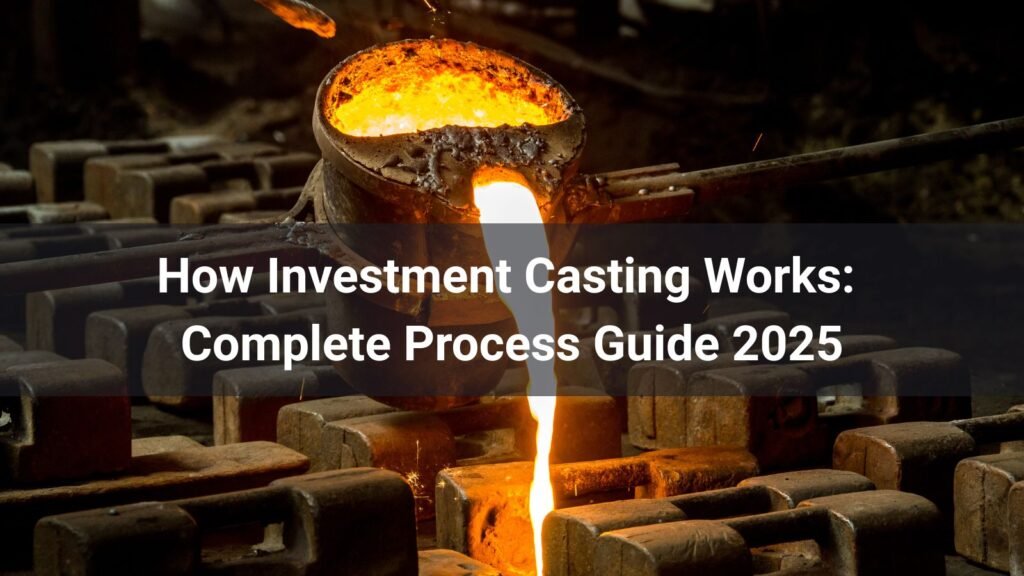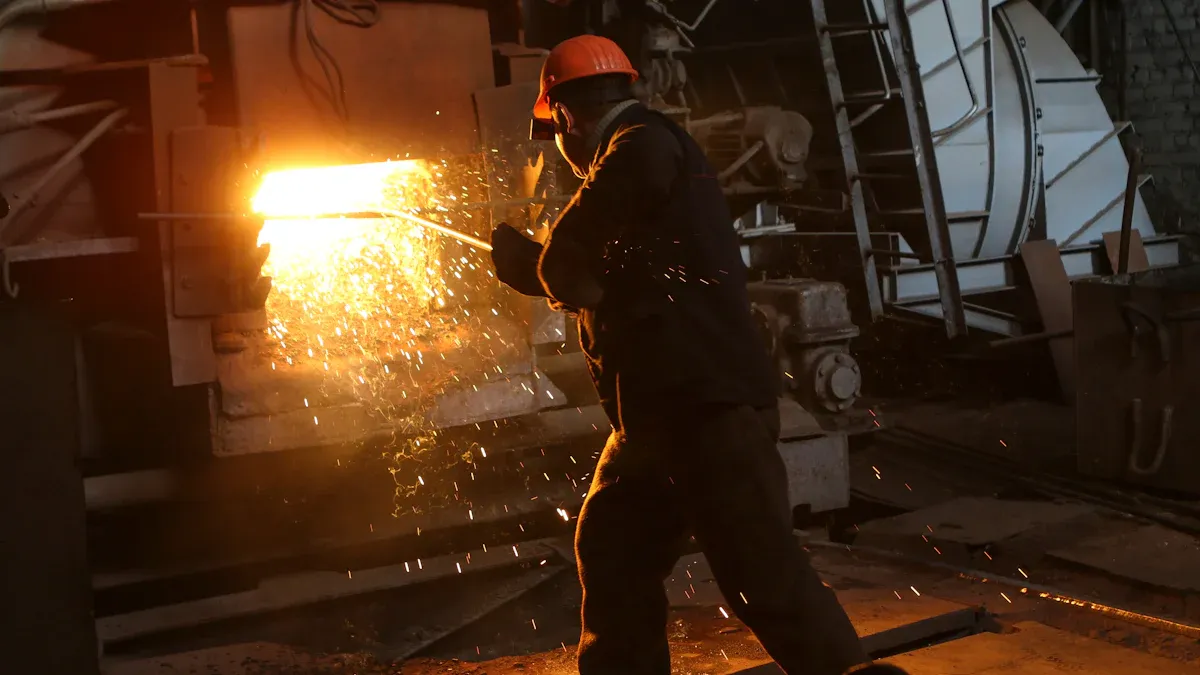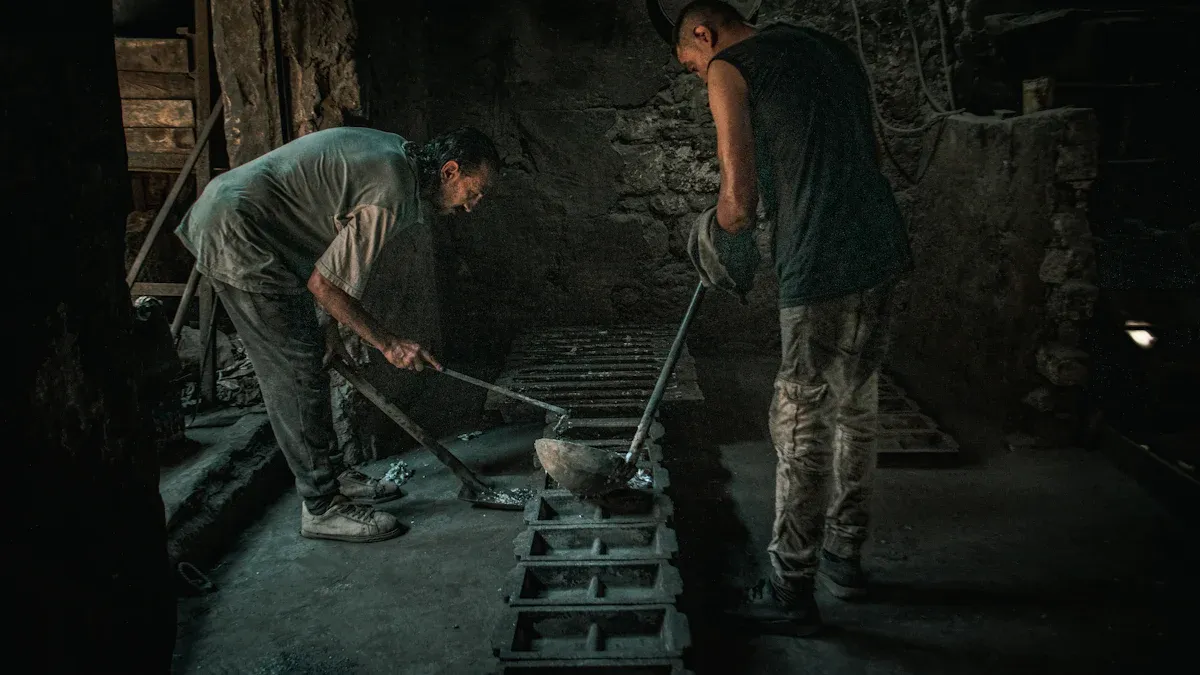
Investment casting, also known as lost-wax casting or precision casting, is one of the most sophisticated manufacturing processes for creating complex metal components with exceptional dimensional accuracy and surface finish. This ancient technique, dating back over 5,000 years, has evolved into a modern industrial process that serves critical industries including aerospace, automotive, medical, and marine applications.
Table of Contents
- What is Investment Casting and How Does It Work?
- The 8-Step Investment Casting Process Explained
- Materials and Applications in Investment Casting
- How to Do Investment Casting at Home
- Quality Control and Testing Methods
- Advantages and Limitations of Investment Casting
- Choosing the Right Investment Casting Partner
What is Investment Casting and How Does It Work?
Investment casting is a precision manufacturing process that creates complex metal parts by surrounding a wax pattern with ceramic material to form a mold. The process involves a detailed eight-stage process, including creating a master pattern and die, producing a wax pattern, creating a ceramic shell and reclaiming wax, pouring metal, and post-processing, all aimed at achieving precise and high-quality castings.
The term “investment” comes from the archaic meaning of “invest,” which refers to surrounding an object with a layer of material. This process allows manufacturers to produce intricate components that would be difficult or impossible to machine using traditional manufacturing methods.
At KEMING Machinery, we have been specializing in investment casting since 2003, developing over 5,000 different products using more than 100 different materials. Our expertise spans across various casting methods including investment casting, shell mold sand casting, lost foam casting, and water glass casting.
Key Characteristics of Investment Casting:
- Exceptional dimensional accuracy (±0.005 inches typical)
- Superior surface finish (125-250 microinches Ra)
- Complex geometries with thin walls and intricate details
- Minimal material waste
- Wide range of compatible materials
The 8-Step Investment Casting Process Explained
Understanding how investment casting is done requires examining each step of this meticulous process. Here’s a comprehensive breakdown of how the investment casting process works:
Step 1: Master Pattern Creation
The process begins with creating a master pattern that serves as an exact duplicate of the final product. Modern manufacturers increasingly use 3D printing technology to create master patterns due to improved dimensional accuracy and compatibility with CAD/CAM systems.
Step 2: Master Die Production
The master pattern is used to create a master die, typically made from aluminum or other suitable materials. The die creation technique depends on the master pattern material and the required production volume.
Step 3: Wax Pattern Formation
Wax patterns are produced from the master die using two primary methods:
- Hollow Pattern Method: The die is filled with a small amount of wax and shaken until it evenly coats the inner surface
- Solid Pattern Method: The die is completely filled with wax through direct feeding or high-pressure injection
Step 4: Ceramic Shell Mold Creation
The wax pattern is repeatedly dipped into a ceramic slurry and coated with refractory sand to build up the ceramic shell. This process typically involves 5-8 coats to achieve the desired thickness and strength.
| Coating Layer | Material Type | Purpose |
|---|---|---|
| Primary (1-2) | Fine ceramic slurry | Surface detail capture |
| Backup (3-6) | Coarser refractory | Structural strength |
| Final (7-8) | Seal coat | Crack prevention |
Step 5: Wax Removal (Dewaxing)
The ceramic-coated patterns are placed in an autoclave or furnace where the wax is melted out, leaving a hollow ceramic mold. The wax is typically reclaimed for reuse, making the process more economical and environmentally friendly.
Step 6: Metal Pouring and Solidification
The ceramic molds are preheated and molten metal is poured into them. Various pouring methods can be used:
- Gravity pouring (most common)
- Vacuum-assisted pouring (higher material yield)
- Pressure-assisted pouring
Step 7: Mold Removal (Knockout)
After the metal solidifies and cools, the ceramic shell is broken away using hammering, water jetting, or media blasting. The casting tree with multiple parts is then separated.
Step 8: Finishing Operations
Final processing includes:
- Gate and runner removal
- Surface finishing
- Dimensional inspection
- Heat treatment (if required)
- Machining (minimal, if needed)
Materials and Applications in Investment Casting
Investment casting works with an extensive range of materials, making it suitable for diverse applications. At KEMING, we work with over 100 different materials to meet specific customer requirements.
Common Investment Casting Materials:
Stainless Steel Investment Casting
Stainless steel castings offer superior corrosion resistance and strength, perfect for medical devices, food processing equipment, and chemical industry applications. Understanding the specific properties of different stainless steel grades is crucial for optimal performance.
Carbon Steel Investment Casting
Carbon steel provides excellent strength and hardness at a cost-effective price point, making it ideal for automotive components, gears, and valves.
Aluminum Investment Casting
Aluminum castings are lightweight with excellent thermal conductivity, perfect for aerospace and automotive applications where weight reduction is critical.
Alloy Steel Investment Casting
Alloy steels combine strength, toughness, and wear resistance, suitable for high-stress applications in automotive and industrial machinery.
Industry Applications:
| Industry | Common Components | Key Requirements |
|---|---|---|
| Aerospace | Turbine blades, engine components | High temperature resistance, precision |
| Automotive | Engine parts, transmission components | Strength, wear resistance, cost-effectiveness |
| Medical | Surgical instruments, implants | Biocompatibility, precision, surface finish |
| Marine | Propellers, pump components | Corrosion resistance, durability |
How to Do Investment Casting at Home
While commercial investment casting requires sophisticated equipment, enthusiasts can perform basic investment casting at home for small projects like jewelry or artistic pieces. Here’s how to do investment casting on a smaller scale:
Basic Home Investment Casting Setup:
Materials Needed:
- Casting wax or paraffin
- Investment powder (plaster of Paris can substitute for beginners)
- Metal for casting (bronze, brass, or aluminum)
- Furnace or kiln
- Crucible
- Safety equipment
Simplified Process:
- Create Wax Model: Carve or mold your desired shape in wax
- Build Investment: Mix investment powder with water and pour around wax model
- Burn Out Wax: Place in kiln to melt out wax at 1000°F (538°C)
- Pour Metal: Heat metal to liquid state and pour into mold
- Break Away Mold: After cooling, break away investment material
- Finish: Clean and polish the casting
Safety Note: Home investment casting involves high temperatures and molten metal. Always wear appropriate safety equipment including heat-resistant gloves, safety glasses, and work in a well-ventilated area.
Quality Control and Testing Methods
Quality control is crucial in investment casting to ensure parts meet specifications and safety requirements. KEMING Machinery employs comprehensive quality control measures throughout the casting process.
Testing Methods Used at KEMING:
Hardness Testing
We perform multiple hardness tests including Brinell, Rockwell, and Vickers testing to ensure material properties meet specifications.
Magnetic Particle Inspection (MPI)
Our wet MPI method provides enhanced sensitivity, detecting surface and near-surface discontinuities with maximum depth detection of 1/4 inch.
Material Composition Testing
Chemical analysis is conducted on each batch of metal ingot before use, with additional testing on molten metal before pouring and completed samples.
X-Ray Testing
Non-destructive X-ray testing detects internal defects including gas porosity, shrinkage, cracks, and other discontinuities that could affect part performance.
| Test Method | Purpose | Standards Applied |
|---|---|---|
| Dimensional Inspection | Verify tolerances | ASTM, DIN, JIS |
| Surface Roughness | Finish quality | Ra 1.6-6.3 μm typical |
| Mechanical Properties | Strength verification | Material specifications |
| Visual Inspection | Surface defects | Industry standards |
International Standards Compliance
KEMING adheres to multiple international standards including Chinese GB, American ASTM and AISI, German DIN, French NF, British BS, Japanese JIS, Australian AS, and Association of American Railroads (AAR) requirements.
Advantages and Limitations of Investment Casting
Advantages of Investment Casting:
- Exceptional Accuracy: Achieves tolerances of ±0.005 inches (±0.13mm)
- Superior Surface Finish: 125-250 microinches Ra surface finish
- Complex Geometries: Can cast intricate shapes impossible with other methods
- Material Versatility: Compatible with over 100 different alloys
- Minimal Machining: Often produces near-net shape parts
- No Parting Lines: Single-piece molds eliminate parting line marks
- Design Freedom: Allows for undercuts, thin walls, and complex internal passages
Limitations of Investment Casting:
- Size Restrictions: Limited to parts typically under 100 pounds
- Higher Initial Costs: More expensive tooling and longer cycle times
- Process Complexity: Requires skilled technicians and process control
- Lead Time: Longer production cycles compared to machining
- Internal Cavities: Challenging to cast complex internal features
Choosing the Right Investment Casting Partner
Selecting the right investment casting manufacturer is crucial for project success. When choosing an alloy steel casting partner, consider these key factors:
Key Selection Criteria:
Experience and Expertise
KEMING brings over 20 years of experience in investment casting, with a proven track record of developing more than 5,000 different products across various industries.
Manufacturing Capabilities
Our facility features:
- 5,000 square meter factory
- 30 advanced lathes and 10 CNC machines
- Two complete casting production lines
- Annual capacity exceeding 2,000 tons
- Dedicated inspection workshop
Quality Systems
Comprehensive quality control including hardness testing, magnetic particle inspection, material testing, and X-ray examination ensures consistent quality.
Material Expertise
Working with 100+ materials including stainless steel, carbon steel, alloy steel, aluminum, and specialized alloys for specific applications.
Why Choose KEMING as Your Investment Casting Manufacturer?
- Proven Experience: 20+ years specializing in investment casting
- Advanced Equipment: Modern CNC machines and casting equipment
- Quality Assurance: Comprehensive testing and international standards compliance
- Flexible Service: OEM and ODM casting solutions
- Global Standards: Compliance with ASTM, DIN, JIS, and other international standards
When deciding between investment casting and other manufacturing methods, consider your specific requirements for accuracy, surface finish, complexity, and production volume.
Getting Started with Your Investment Casting Project
Ready to begin your investment casting project? KEMING Machinery offers comprehensive consultation services to help determine the best approach for your specific requirements. Our experienced team can assist with:
- Material selection and optimization
- Design for manufacturability analysis
- Cost estimation and production planning
- Quality requirements definition
- Timeline development
For expert investment casting services and consultation, contact KEMING Machinery today. Visit our website at kminvestmentcast.com or reach out to our technical team to discuss your specific project requirements. With our advanced facilities, experienced team, and commitment to quality, we’re ready to help bring your precision casting projects to life.
Whether you need automotive components, medical devices, or specialized industrial parts, KEMING’s investment casting capabilities can deliver the precision and quality your applications demand.




